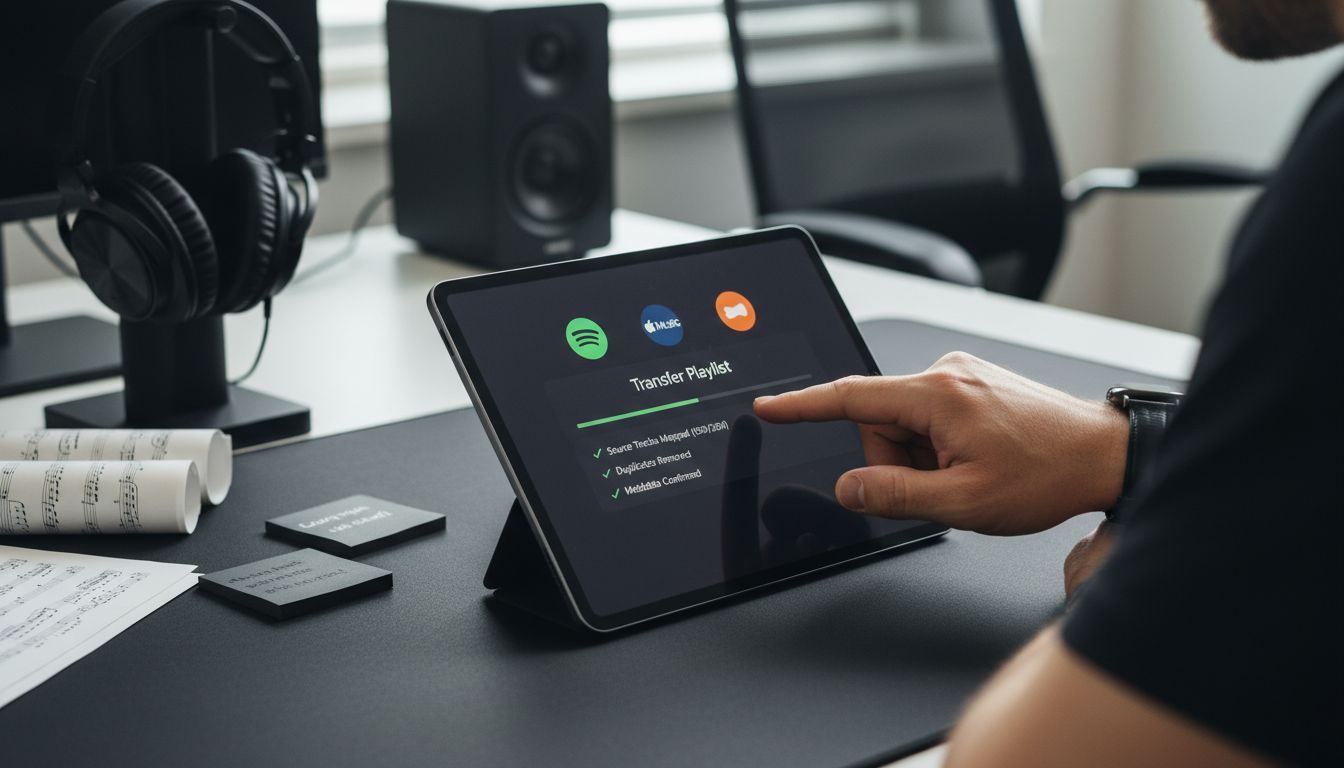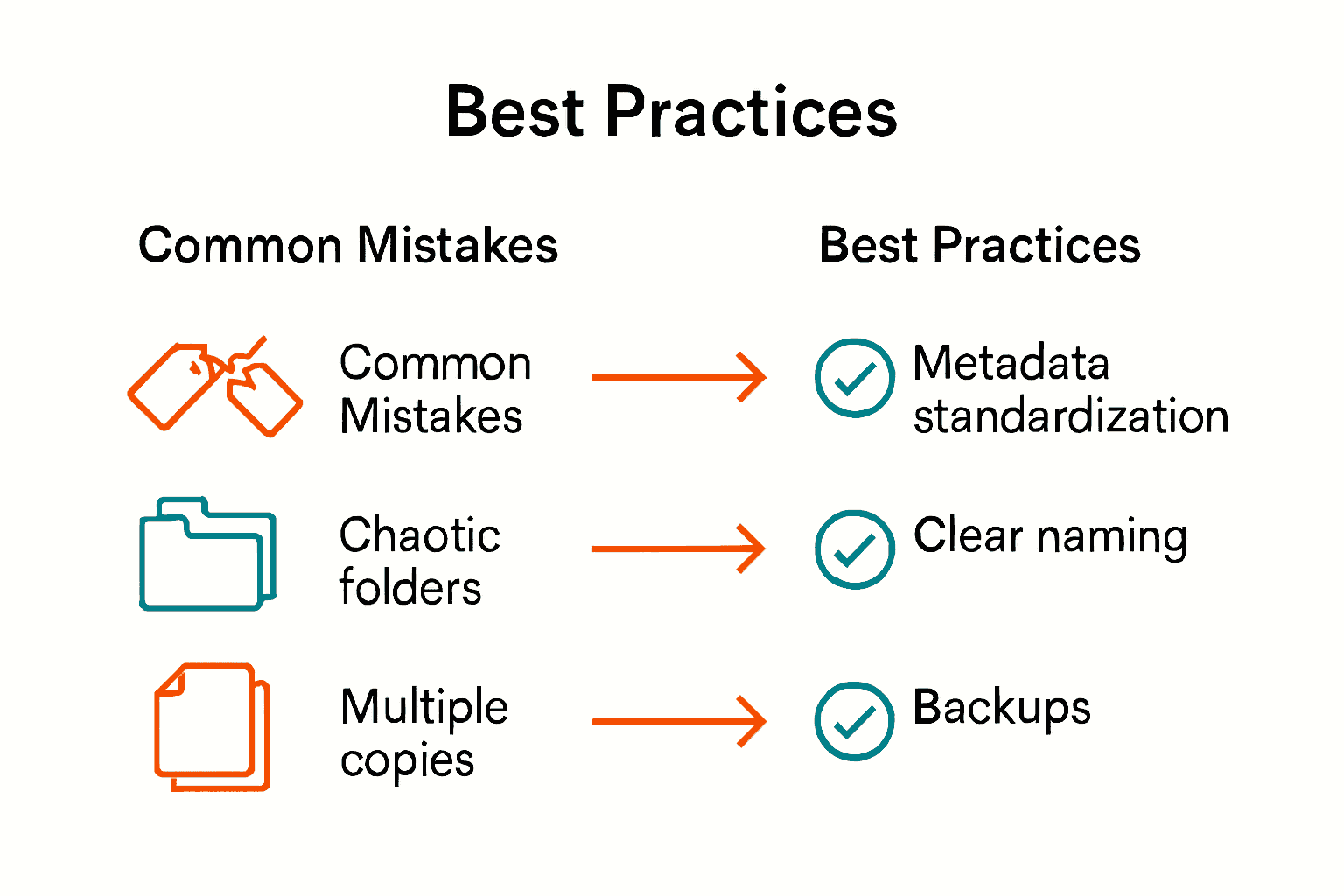Did you know over 60 million songs are available across today’s major streaming platforms? Keeping all that music neatly organized is tougher than it seems. Whether you are managing playlists for casual listening or archiving tracks for research, a clear system saves time and stress. Learn how smart strategies and modern tools can turn endless song files into a personalized library that matches your needs.
Table of Contents
- Defining The Music Library Management Process
- Types Of Music Libraries And Platforms
- How Playlist Migration And Sync Work
- Essential Features For Library Organization
- Common Challenges And Mistakes To Avoid
Key Takeaways
| Point | Details |
|---|---|
| Music Library Management | A systematic approach to organizing and accessing music collections, requiring effective metadata, backup strategies, and accessibility considerations. |
| Types of Music Libraries | Includes commercial, non-profit, personal, and specialized libraries, each serving distinct purposes in the digital landscape. |
| Playlist Migration | Involves sophisticated algorithms for seamless song transfers between platforms, focusing on accurate track identification and playlist integrity. |
| Common Challenges | Key pitfalls include metadata inconsistency, neglecting backups, and platform lock-in, which can be mitigated through standardization and proactive management strategies. |
Defining the Music Library Management Process
Music library management represents a systematic approach to organizing, preserving, and accessing music collections across physical and digital platforms. According to New World Encyclopedia, music libraries encompass extensive collections that include "dictionaries, encyclopedias, indexes, directories, printed music, music serials, bibliographies, and other music literature."
At its core, music library management involves several critical components that transform scattered audio files and playlists into a coherent, easily navigable system. These components include categorization, metadata tagging, backup strategies, and cross-platform synchronization. CLRN highlights that such libraries serve multiple purposes, functioning as "resources for education, research, and performance."
Effective music library management requires strategic planning and the right tools. Key considerations include:
- Metadata Accuracy: Ensuring each track has complete information like artist, album, genre, and year
- Redundancy Protection: Creating multiple backup strategies to prevent music loss
- Scalability: Designing a system that can grow with your music collection
- Accessibility: Making your library easily searchable and playable across different devices
Modern digital platforms have revolutionized how individuals approach music library management, transforming what was once a complex, manual process into a streamlined, automated experience. By leveraging advanced synchronization technologies, music enthusiasts can now maintain comprehensive collections that adapt seamlessly to their evolving musical preferences.
Types of Music Libraries and Platforms
Music libraries have evolved dramatically with the digital revolution, spanning diverse platforms and serving multiple purposes. According to New World Encyclopedia, there are four primary types of music libraries: those supporting university music departments, conservatory music schools, public libraries, and independent music organization archives.
Digital music platforms have dramatically expanded these traditional library models. CLRN categorizes modern music libraries based on ownership, purpose, and target audience, which now include:
- Commercial Music Libraries: Streaming services like Spotify, Apple Music, and Tidal
- Non-Profit Music Libraries: Academic and research-focused digital archives
- Personal Music Libraries: Individual collections managed through cloud platforms
- Specialized Music Libraries: Genre-specific or professionally curated collections
The contemporary music library landscape integrates multiple technologies, allowing seamless transitions between physical and digital environments. Streaming platforms have become the primary mechanism for music library management, offering unprecedented accessibility and personalization. By leveraging advanced algorithms and user-generated playlists, these platforms transform how we discover, organize, and experience music.

Understanding the nuanced ecosystem of music libraries requires recognizing their dynamic nature. Modern platforms transfer playlists from YouTube Music to SoundCloud and other services, highlighting the interconnected and fluid nature of digital music collections. Whether you're a casual listener or a music professional, these evolving platforms offer unprecedented flexibility in managing your audio universe.
How Playlist Migration and Sync Work
Playlist migration and synchronization represent sophisticated technological processes that enable seamless music library transfers across different platforms. According to arXiv, this involves developing advanced cross-modal music retrieval algorithms that can identify and match music across various digital environments.
Music library synchronization relies on complex technical infrastructures. DISIT emphasizes that effective migration depends on robust identification and classification systems, which ensure accurate track matching and preservation of playlist integrity.
The migration process typically involves several critical steps:
- Track Identification: Matching songs across different platforms using metadata
- Metadata Mapping: Translating track information between varied streaming services
- Playlist Reconstruction: Rebuilding playlist structures with maximum accuracy
- Duplicate Prevention: Eliminating redundant or incorrect track entries
Modern playlist migration technologies leverage sophisticated matching algorithms that analyze multiple track attributes. These systems go beyond simple title matching, examining elements like artist name, album information, release year, and acoustic fingerprints to ensure precise transfers.
For music enthusiasts seeking comprehensive solutions, Free Your Music: Ultra Simple Transfer of Playlists offers a streamlined approach to managing music libraries across diverse platforms. The evolving landscape of digital music management continues to simplify what was once a complex and time-consuming process, empowering users to maintain their musical collections with unprecedented ease and flexibility.
Essential Features for Library Organization
Organizing a music library requires sophisticated infrastructure and strategic planning. According to DISIT, music libraries represent one of the most complex media collections, demanding highly specialized cataloging and indexing rules that go far beyond traditional library management approaches.
The fundamental elements of effective library organization encompass multiple technical and user-experience dimensions. CLRN highlights the critical importance of Content Delivery Network (CDN) integration to ensure fast and reliable audio file distribution across global platforms.
Key features for comprehensive music library organization include:
- Metadata Standardization: Ensuring consistent and accurate track information
- Intelligent Categorization: Automatic genre, mood, and style classification
- Cross-Platform Compatibility: Seamless integration across multiple streaming services
- Adaptive Tagging Systems: Dynamic metadata adjustment and enrichment
- Redundancy and Backup Mechanisms: Protecting user collections from potential data loss
Advanced library management goes beyond simple storage. Modern systems leverage machine learning algorithms to create intelligent, self-organizing libraries that adapt to user preferences, analyze listening patterns, and provide personalized recommendations.
For music enthusiasts seeking comprehensive solutions, Free Your Music: Ultra Simple Transfer of Playlists offers an integrated approach to managing complex music collections. The future of music library organization lies in creating intelligent, flexible systems that transform how we discover, store, and interact with our musical universes.
Common Challenges and Mistakes to Avoid
Music library management presents numerous complex challenges that can derail even the most well-intentioned digital music collection strategies. According to DISIT, music libraries require a sophisticated infrastructure for identification and classification, making them one of the most challenging media collections to manage effectively.
Metadata inconsistency represents a primary obstacle in music library organization. CLRN emphasizes the critical importance of ensuring fast and reliable audio file delivery, which becomes exponentially more difficult when metadata remains unstructured or incomplete.
Common pitfalls in music library management include:
- Incomplete Metadata: Failing to capture comprehensive track information
- Inconsistent Naming Conventions: Creating chaos through random file and playlist labeling
- Duplicate Track Management: Allowing multiple versions of the same track to clutter collections
- Neglecting Backup Strategies: Risking total loss of carefully curated music libraries
- Platform Lock-In: Becoming overly dependent on a single streaming service
Successful music library management requires a proactive approach that anticipates potential challenges. Users must develop systematic strategies for metadata maintenance, regularly audit their collections, and remain flexible across different streaming platforms.
For those seeking a comprehensive solution to these challenges, Free Your Music: Ultra Simple Transfer of Playlists offers a streamlined approach to managing complex music collections. By understanding and addressing these common pitfalls, music enthusiasts can create robust, adaptable libraries that preserve their musical memories and discoveries.
Here's a comparison of common music library challenges and best practices to avoid them:

| Challenge | Common Mistake | Best Practice |
|---|---|---|
| Metadata Inconsistency | Missing or incomplete track info | Standardize metadata |
| Inconsistent Naming | Random file and playlist names | Use clear naming rules |
| Duplicate Tracks | Multiple versions clutter collection | Deduplicate regularly |
| Lack of Backup | No backup or redundancy | Implement backup strategies |
| Platform Lock-In | Relying on one streaming service | Ensure cross-platform access |
Simplify Your Music Library Management with Effortless Playlist Transfers
Managing a complex music library means tackling metadata inconsistencies, platform lock-in, and the frustration of rebuilding playlists manually. If you want to maintain an organized, scalable, and accessible music collection without the usual headaches, understanding the migration and synchronization process is essential. With the challenges of duplicate tracks and maintaining playlist structure, having a reliable tool can make all the difference.

Take control of your music universe today with Free Your Music, a tailored solution designed to transfer unlimited playlists accurately across platforms like Spotify, Apple Music, Tidal, and many more. Say goodbye to lost songs and incomplete metadata with automated syncing and cloud backup features that keep your collection safe and consistent. Start your seamless playlist migration now and experience the freedom to switch streaming services whenever you want without losing your carefully curated music library.
Frequently Asked Questions
What is music library management?
Music library management refers to the systematic process of organizing, preserving, and accessing music collections across various platforms. It involves components like categorization, metadata tagging, and backup strategies to create an easily navigable system.
Why is metadata accuracy important in music libraries?
Metadata accuracy is crucial as it ensures that each music track contains complete and correct information such as artist, album, genre, and year. This enhances the searchability and usability of the music library, making it easier for users to locate and enjoy their collections.
What are common challenges in managing a music library?
Common challenges include metadata inconsistency, incomplete track information, duplicate tracks, neglecting backup strategies, and platform lock-in, which can complicate the organization and accessibility of music collections.
How can I effectively back up my music library?
To effectively back up your music library, implement multiple backup strategies, such as using cloud storage, external hard drives, and regular updates of your collection to safeguard against data loss and ensure music preservation.





